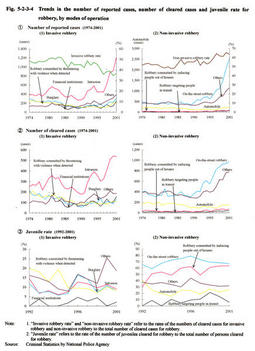| Previous Next Index Image Index Year Selection | |
|
|
4 Trends of robbery by modes of operation Among offenses that are of a strong violent nature, this subsection focuses on robbery, which is likely to occur in everyday life but cause serious damage. Fig. 5-2-3-4 shows the trends in the number of reported cases, the number of cleared cases and the juvenile rate for invasive robbery and non-invasive robbery, by modes of operation. The names of modes of operation mentioned in this subsection are based on the Criminal Statistics by the National Police Agency.
Among the mode of operation for invasive robbery, the number of robberies involving "intrusion" has been rapidly increasing. "Intrusion" refers to the act of breaking and entering houses in the daytime or before people in the houses go to sleep at night and robbing people of money and articles. Along with the number of robberies involving "intrusion", the number of "robbery targeting financial institutions" has also been increasing: after staying within the range between 100 and 150 cases per annum, the number increased rapidly to 229 in 2001 (see Fig. 1-1-1-12 in Part 1, Chapter 1). In particular, the number of robberies targeting post offices, which been under 100 until 2000, increased rapidly to 152 in 2001. In consideration of frequent occurrence of convenience store robbery, the National Police Agency independently conducts statistical surveys on "robbery targeting overnight supermarkets". The number of convenience store robberies has also been increasing significantly since 1998 (see Fig. 1-1-1-13 in Part 1, Chapter 1). With respect to invasive robbery, the following 2 matters can be pointed out: (1) the rapid increase in the number of robberies involving "intrusion" into private residences, stores and offices; and (2) the rapid increase in the number of robberies committed in places where there are only a small number of people and it is relatively, easy to commit robbery, such as convenience stores. By adopting these modes of operation, it seems to be easy not only to commit robbery quickly without making a preliminary examination of the site or making preparation sufficiently but also to get away after committing the robbery because only a small number of people will chase the perpetrator; therefore, these modes are highly likely to be followed. With respect to non-invasive robbery, the number of on-the-street robberies increased sharply, about4.5-fold, over the past 10 years. Especially in the past 2 or 3 years, there is an outstanding increase in the number of on-the-street robberies committed by adult offenders. "On-the-street robbery" refers to the act of robbing passers-by of their money and articles on the street (Source: Criminal Statistics by National Police Agency). This seems to be a major factor that has raised the rate of robbery committed outdoors. Robbery committed by robbing bankers, etc. of cash while they are transporting the cash or robbing people of cash, etc. while they are on the way to banks or post offices to deposit money or from these financial institutions after making withdrawals is included in the category of non-invasive robbery as "robbery targeting people in transit, separately from robbery targeting financial institutions and on-the-street robbery. By modes of operation, the juvenile rates for "intrusion", "burglary (breaking and entering houses after people in the houses go to sleep at night and robbing people of money and articles)", and "robbery committed without violent intent but in which the threat of violence is used when detected", all of which are included in the category of invasive robbery, have been showing almost the same trend and they have been about 10% in the past 2 or 3 years. In the category of non-invasive robbery, it is noticeable that the juvenile rate for on-the-street robbery has been about 70%, although showing a repeated trend of increase and decrease. It should also be noted that the juvenile rate for "robbery committed by inducing people out of houses, etc." has been increasing in these years as sharply as the rate for on-the-street robbery. Fig. 5-2-3-4 Trends in the number of reported cases, number of cleared cases and juvenile rate for robbery, by modes of operation |
